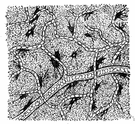ar·te·ri·ole
(är-tîr′ē-ōl′)n.
One of the small terminal branches of an artery, especially one that connects with a capillary.
[New Latin artēriola, diminutive of Latin artēria, artery, from Greek artēriā; see wer- in Indo-European roots.]
ar·te′ri·o′lar (-ō′lər, -ə-lər) adj.
American Heritage® Dictionary of the English Language, Fifth Edition. Copyright © 2016 by Houghton Mifflin Harcourt Publishing Company. Published by Houghton Mifflin Harcourt Publishing Company. All rights reserved.
arteriole
(ɑːˈtɪərɪˌəʊl)n
(Anatomy) anatomy any of the small subdivisions of an artery that form thin-walled vessels ending in capillaries
[C19: from New Latin arteriola, from Latin artēria artery]
Collins English Dictionary – Complete and Unabridged, 12th Edition 2014 © HarperCollins Publishers 1991, 1994, 1998, 2000, 2003, 2006, 2007, 2009, 2011, 2014
ar•te•ri•ole
(ɑrˈtɪər iˌoʊl)n.
any of the smallest branches of an artery.
[1830–40; < New Latin artēriola]
ar•te`ri•o′lar, adj.
Random House Kernerman Webster's College Dictionary, © 2010 K Dictionaries Ltd. Copyright 2005, 1997, 1991 by Random House, Inc. All rights reserved.
ar·te·ri·ole
(är-tîr′ē-ōl′) Any of the smaller branches of an artery, especially one that ends in the capillaries.
The American Heritage® Student Science Dictionary, Second Edition. Copyright © 2014 by Houghton Mifflin Harcourt Publishing Company. Published by Houghton Mifflin Harcourt Publishing Company. All rights reserved.
arteriole
A small artery supplying blood from a main artery to a capillary.
Dictionary of Unfamiliar Words by Diagram Group Copyright © 2008 by Diagram Visual Information Limited
ThesaurusAntonymsRelated WordsSynonymsLegend:
| Noun | 1. |  arteriole - one of the small thin-walled arteries that end in capillaries arteriole - one of the small thin-walled arteries that end in capillariesarteria, arterial blood vessel, artery - a blood vessel that carries blood from the heart to the body |
Based on WordNet 3.0, Farlex clipart collection. © 2003-2012 Princeton University, Farlex Inc.